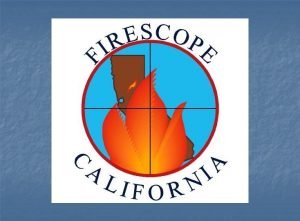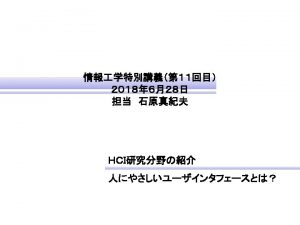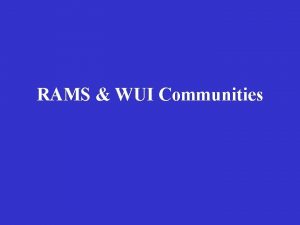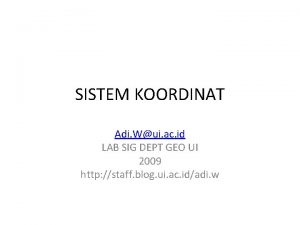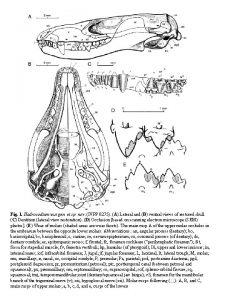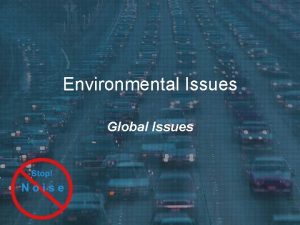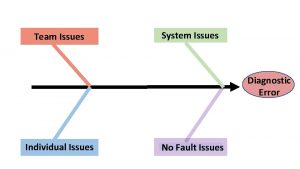Presentation 1 2 Key WUI Issues in the






































- Slides: 38

Presentation 1. 2: Key WUI Issues in the South

Outline • Introduction • Exercise 1. 3: Prioritizing Interface Issues • Key WUI Issues • Case Studies 8, 4 • WUI Connections • Case Studies 5, 7, 11, 16 • Exercise 1. 5: Weaving Connections • Summary

Introduction l Key WUI issues vary from state to state, but some are consistent across the South. l What issues are most important in your region? l How are those issues interconnected?

Exercise 1. 3: Prioritizing Interface Issues

Exercise 1. 3: Purpose l This exercise helps us identify critical WUI issues in our region. l We will also identify those that are deemed most critical according to each of us individually and by the group as a whole.

Exercise 1. 3: Discussion Questions How would the priority issues change across the region/state? l Which issues are the consequences of other issues? l If one issue were resolved, which others would disappear? l What are some solutions? l

Demographic changes in the South • Population is projected to increase 24% by 2020 • Percentage of the population made up by Hispanics, African Americans, Asians is increasing • Between 2000 and 2030, number of people aged 65 and over will double

Diverse public attitudes and perceptions Different age and ethnic groups, new and longtime residents may differ in how they use and value natural resources

Economic and taxation issues • Property taxes tend to increase in developing areas, affecting the ability of forest landowners to manage or retain forests. • Heirs are sometimes forced to subdivide or sell family land in order to pay estate taxes.

Land-use planning and policy • Lack of effective growth management • No common approach across jurisdictional boundaries • Regulation of forest practices increases with urbanization

Increase in urban acreage -100 - 5200 5201 - 16400 16401 - 41900 41901 - 91900 Major Highways Land Use Change Increases in urban acreage 1982 -1992

Changes to ecosystems • Fragmented forests • Decreased air and water quality • Reduced or degraded wildlife habitat • Increased nonnative invasive plants

Altered ecosystem goods and services • Tourism and recreation • Air and water purification • Food, wood, and decorative products

Risks from increased human influences Urbanization Floods Wind Fires

Lack of public education • Education about how ecosystems work • Information for newcomers • Science-based information for informed decision making

Challenges of managing natural resources on public lands • Development along boundaries • Pressures from adjacent owners • Higher degree of visibility to a greater population • Problems with trash, fire, non-native invasive plants and animals

Challenges of managing non-industrial private lands • Limited small-scale and alternative management options • Limited markets for traditional forest goods and services • Lack of information and assistance

Case Study 8: Island Interface Issues: Puerto Rico and the Virgin Islands

Managing fire • Limited use of prescribed fire • Concerns with smoke and liability issues • Alternative fuel reduction methods may be needed

Managing recreation • Opportunities decreasing on private lands, puts more pressure on public lands • Need to provide recreation opportunities for diverse users • Potential for conflict between different user groups

Managing and conserving wildlife • Conserving, managing, and restoring wildlife habitat is main challenge • Some species are increasing, others are decreasing • Balancing desire for contact with wildlife with nuisance complaints

Case Study 4: Deer Debate in Hilton Head, South Carolina

Key WUI issues in 6 locations across the South • Twelve focus groups were conducted in 6 states, 173 participants • Represented natural resource management, industry, development, conservation, planning, and other related fields • Some issues were common across all states, others were unique

Birmingham, Alabama • Lack of vision and leadership • Lack of comprehensive land use planning • Water quality and quantity • Education of homeowners, developers, decisionmakers White Co. , Georgia (N. GA mountains) • Erosion and sedimentation • Land is taken out of production by development • Water quality and quantity • Lack of comprehensive land use planning

Deland, Florida (near Daytona Beach) • Education of homeowners and developers • Growth management is needed at all levels • Water quality and quantity • Private property rights The Woodlands, Texas (near Houston) • Population growth and influx of people into WUI • No empowerment of regional planning • Lack of education–students, adults, newcomers • Lack of publicly owned land, overuse of public land.

Orange Grove, Mississippi (near Biloxi) • The influx of people, all competing for a limited resource. • Wildlife habitat is being lost or degraded. • Drainage and wetland issues. • Protection of open space and conservation areas. Loundon County, Virginia (near Wash D. C. ) • Taxes lead to pressures to sell land develop. • Lack of mandate to manage natural resources. • Lack of landscape level planning. • Degraded water quality.

Summary of focus group findings l Common themes included increased land development, transportation issues, challenges managing natural resources in the interface, changes to ecosystems, ineffective planning, and conflicting perceptions and values. l Some regional differences were noted, such as demographic composition and types of land-use policies utilized.

Some WUI connections Ecological changes Factors driving change Water Quality and Quantity Land Use Planning Non-Native Invasive Species Public Policy Demographics Urbanization Economics and Taxation Forest Fragmentation Forest Health Air Quality

Case Study 5: The Domain: Managing Interface Forests in Tennessee

Case Study 7: Interface Issues in the Georgia Mountains

Case Study 11: Life on the Edge: Interface Issues in Bastrop, Texas

Case Study 16: Restoring Coastal Wetlands in Louisiana

Exercise 1. 5: Weaving Connections

Exercise 1. 5: Purpose l This exercise will help us to better understand how WUI issues are interconnected l It will also help us understand different perceptions of WUI issues and consequences for natural resources

Exercise 1. 5: Interface Issues l l l l l Water quality l Water quantity l Non-native invasive l plants l Non-native invasive l animals l Nuisance wildlife l Forest fragmentation l Prescribed burning l Air pollution l Sense of place Groundwater recharge Timber harvesting Urban heat island effect Wildfire Increased land value Sprawl Endangered animal or plan New highway construction Hunting regulations Wildlife habitat

Summary l WUI issues affect the ability of natural resource professionals to work effectively in the WUI l WUI issues are interconnected and cannot be addressed in isolation.

Credits Maps: • Slide 11 - Woods and Poole Economics, Inc. 1997 complete economic and demographic data source. Washington, DC: Woods and Poole Economics. Literature: • Slide 10, 23 -27– Monroe, M; Bowers, A. ; Hermansen, L. A. 2003. The Moving Edge. Gen. Tech. Rep. SRS-63. USDA Forest Service. Photos: • Slides 8, 10, 12, 13, 15, 19, 21 – Larry Korhnak • Slide 8 - James Kundell • Slide 17 – Courtesy of Virginia Tech

For more information about WUI issues refer to: Human Influences on Forest Ecosystems: The Southern Wildland-Urban Interface Assessment GTR SRS-55
 Kris wui
Kris wui Kwok wui san
Kwok wui san Wui windows
Wui windows Wui windows
Wui windows Kris wui
Kris wui Business key activities
Business key activities Key partners key activities key resources
Key partners key activities key resources Presentation layer design issues
Presentation layer design issues Presentation layer protocols
Presentation layer protocols Hát kết hợp bộ gõ cơ thể
Hát kết hợp bộ gõ cơ thể Frameset trong html5
Frameset trong html5 Bổ thể
Bổ thể Tỉ lệ cơ thể trẻ em
Tỉ lệ cơ thể trẻ em Voi kéo gỗ như thế nào
Voi kéo gỗ như thế nào Tư thế worms-breton
Tư thế worms-breton Chúa yêu trần thế
Chúa yêu trần thế Kể tên các môn thể thao
Kể tên các môn thể thao Thế nào là hệ số cao nhất
Thế nào là hệ số cao nhất Các châu lục và đại dương trên thế giới
Các châu lục và đại dương trên thế giới Công thức tiính động năng
Công thức tiính động năng Trời xanh đây là của chúng ta thể thơ
Trời xanh đây là của chúng ta thể thơ Mật thư anh em như thể tay chân
Mật thư anh em như thể tay chân Làm thế nào để 102-1=99
Làm thế nào để 102-1=99 độ dài liên kết
độ dài liên kết Các châu lục và đại dương trên thế giới
Các châu lục và đại dương trên thế giới Thể thơ truyền thống
Thể thơ truyền thống Quá trình desamine hóa có thể tạo ra
Quá trình desamine hóa có thể tạo ra Một số thể thơ truyền thống
Một số thể thơ truyền thống Cái miệng nó xinh thế chỉ nói điều hay thôi
Cái miệng nó xinh thế chỉ nói điều hay thôi Vẽ hình chiếu vuông góc của vật thể sau
Vẽ hình chiếu vuông góc của vật thể sau Thế nào là sự mỏi cơ
Thế nào là sự mỏi cơ đặc điểm cơ thể của người tối cổ
đặc điểm cơ thể của người tối cổ V cc cc
V cc cc Vẽ hình chiếu đứng bằng cạnh của vật thể
Vẽ hình chiếu đứng bằng cạnh của vật thể Vẽ hình chiếu vuông góc của vật thể sau
Vẽ hình chiếu vuông góc của vật thể sau Thẻ vin
Thẻ vin đại từ thay thế
đại từ thay thế điện thế nghỉ
điện thế nghỉ Tư thế ngồi viết
Tư thế ngồi viết
